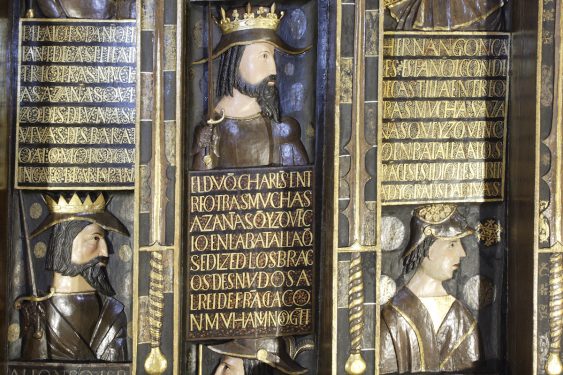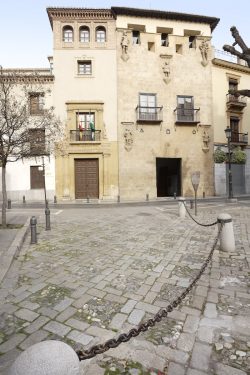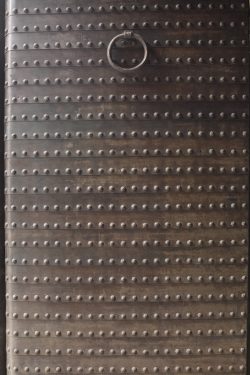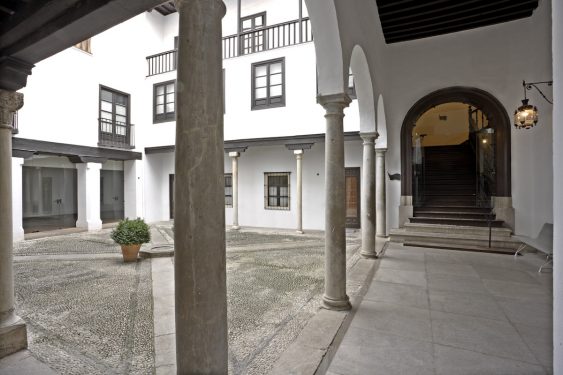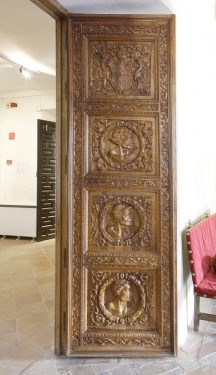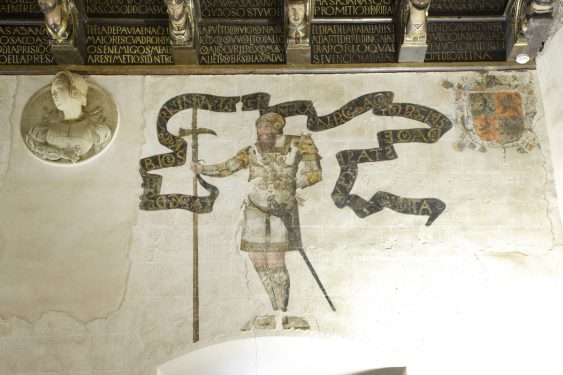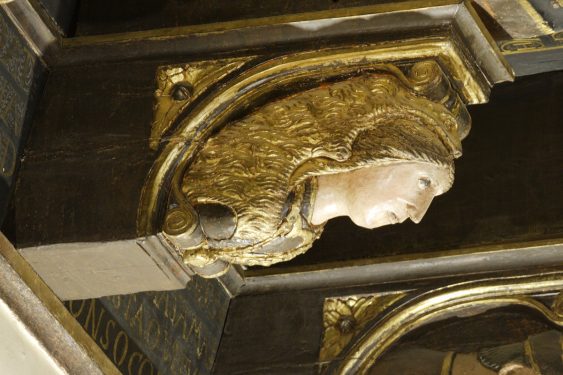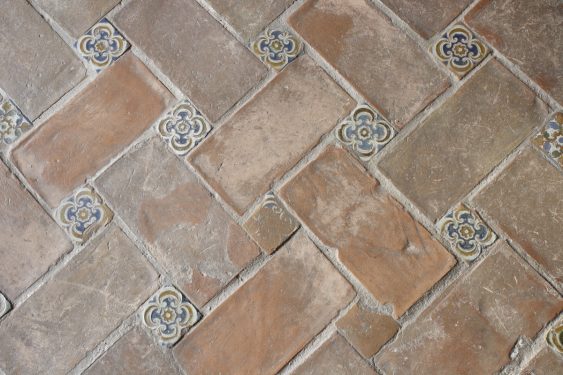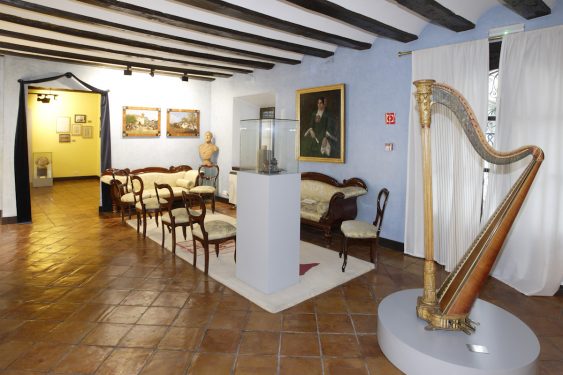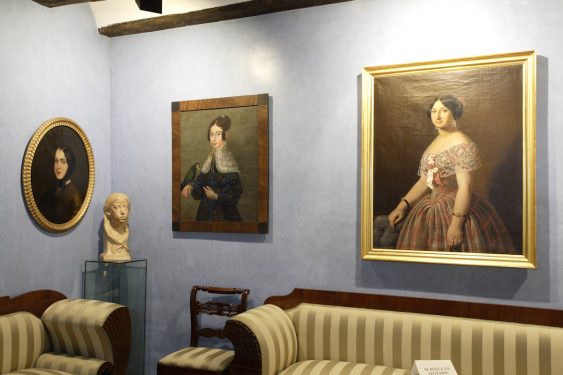Sixteenth century building, converted into a museum, where Lorca read Yerma in 1934 and where the edition of the Divan del Tamarit was prepared.
The Casa de los Tiros (House of the Shots) is linked to Federico García Lorca by a double circumstance. In the romantic hall of this original 16th century building, which has undergone numerous changes and additions, the poet read on September 27, 1934 Yerma to a group of friends and, most importantly, for the first time announced the new project he was working on, Divan del Tamarit, which would be his last book and which appeared posthumously, in 1940, in the Losada publishing house of Buenos Aires and in the New York publication Revista Hispánica Moderna.
Divan del Tamarit is composed of about twenty poems between casidas (in Arabic lyric poetry, any composition of a certain length that respects a certain internal structure) and ghazals (in its original meaning, short poems of erotic character) that pay homage to the Arab-Andalusian poets and refer to the Huerta del Tamarit, a country house owned by the Lorca family located next to the Huerta de San Vicente (San Vicente Farmhouse) and which the poet frequented during his summer visits to Granada.
In 1922, the Casa de los Tiros hosted the selective recitals of the Flamenco Song Contest which were attended by García Lorca and Manuel de Falla, among others.
The recital of Yerma in July 1934 was attended by the then dean of the Faculty of Arts Antonio Gallego Burín, the architect Francisco Prieto Moreno and the Arabist Emilio García Gómez, among others. From that meeting came the determination to publish Divan in the publishing house of the University of Granada with a foreword by the Arabist.
Emilio García Gómez fulfilled his commitment and left an introduction ready that later appeared randomly in The Moor’s Chair and New Andalusian Scenes where he recounts the origin of the failed book and comments on Lorca’s poems. Those attending finalized the details in the restaurant Los Manueles, a “traditional dining-room on a background of drunken voices where the couplets were rotting”.
“I was telling Lorca that my purpose was to dedicate a book to an Arab magnate – Ibn Zamrak – whose poems have been published in the most luxurious edition the world knows: the Alhambra itself, where they cover the walls, adorn the halls and surround the cup of the jumpers. Lorca told us then that, in tribute to those ancient poets of Granada, he had composed a collection of qasidas and ghazals, that is, a divan that is the name of this family home, where many of them were written, would be called Tamarit”, writes García Gómez.
Antonio Gallego Burín asked him for the manuscript; Francisco Prieto-Moreno offered to design the cover and García Gómez offered to write the prolog. The outbreak of the Civil War put the project on hold.
The Casa de los Tiros was the space chosen by Manuel de Falla for the rehearsals of his Concerto for harpsichord with the members of the Bética Orchestra. “The musicians were exhausted, while he wiped his forehead and glistening bald head with a handkerchief. It was scarcely believable that that frail and petite figure could develop such a wealth of physical energy,” recounts Francisco García Lorca in his memoirs.
By the summer of 1931, Lorca had already written at least three poems of the Divan del Tamarit.
In 1935, according to the testimony of Eduardo Blanco Amor, he wrote in a café in the Zacatín The Ghazal of the Morning Market, which was not included in the original edition.
Todas las tardes en Granada,
[Every evening in Granada,]
todas las tardes se muere un niño.
[every evening there is a boy dying.]
Todas las tardes el agua se sienta
[Every evening he sits under water]
a conversar con sus amigos.
[talking with his friends.]
Los muertos llevan alas de musgo.
[The dead have wings of moss.]
El viento nublado y el viento limpio
[The cloudy wind and the clear wind]
son dos faisanes que vuelan por las torres
[are two pheasants flying by the towers]
y el día es un muchacho herido.
[and the day is a wounded boy.]
No quedaba en el aire ni una brizna de alondra
[There was not a trace of skylark in the air]
cuando yo te encontré por las grutas del vino
[when I found you by the wine caves.]
No quedaba en la tierra ni una miga de nube
[There was not a wisp of cloud]
cuando te ahogabas por el río.
[when you were drowning in the river.]
Un gigante de agua cayó sobre los montes
[A water giant fell upon the mountains]
y el valle fue rodando con perros y con lirios.
[and the valley roiled with dogs and lilies.]
Tu cuerpo, con la sombra violeta de mis manos,
[Your body, by my hands’ violet shadows,]
era, muerto en la orilla, un arcángel de frío.
[was, dead on the shore, a frozen archangel.]
- Emilio García Gómez. Silla del Moro and new Andalusian scenes. Austral. Buenos Aires, 1954.
- Emilio García Gómez. Lorca and his ‘Divan del Tamarit’. ABC, 5 February 1982.
- Isabel García Lorca. My Memories. Tusquets. Barcelona, 2002.
- Francisco García Lorca. Federico and his world. Alianza Tres. Madrid 1990.
- Lorca´s location
- Casa de los Tiros
- current location
- Casa de los Tiros Museum
- ADDRESS
- Pavaneras, 19
- Web
- http://www.museosdeandalucia.es/web/museocasadelostirosdegranada
- Telephone
- 600 143 175
- museocasadelostiros.ccul@juntadeandalucia.es
- DETAILS OF THE VISIT
The Casa de los Tiros was built between 1530 and 1540 in the style of the Granada palaces of the time. It gets its name from the cannons that protrude between its battlements. It was part of the wall of the Alfareros neighborhood, hence its appearance of a military fortress.
From the original building only the Tower is preserved, around which several constructions have been built later. It highlights the polychrome coffered ceiling of the Gilded Room or main hall, as well as the plateresque doors.
In 1921 it became state property and since then is the headquarters of the Museum of the Casa de los Tiros and houses the book and newspaper library on Granada topics.
Please, check the museum website for information on opening hours.
